I’m using this blog post as an opportunity to break down a talk I gave at Search London on Feb 28th 2023. This was on the topic of maximising SERP real estate on China’s major search engine, Baidu.
The talk doesn’t go into too much detail over ranking factors and algorithmic differences when it comes to Baidu vs Google. I’ve covered this before and so have others in much more detail (see resources at the end).
The talk is rather a strategic approach on how to succeed in China SEO in the context of how the SERP is made up and where you need to focus your efforts to gain visibility.
I’ve since shared my talk on social media via SlideShare though given SlideShare’s recent annoying injection of compulsory ad viewing after every other slide I thought I’d use this space to make the points covered in the talk more widely available.
The in-person event also happened on a chilly Tuesday evening in London in February, which may not have been enticing to everyone to attend.
Before I begin, there is a video of the talk on a delisted YouTube link. Given that this was a ticketed event, the organisers understandably don’t want the videos widely shared on social. However, if you’d like to see the video of me delivering the talk then get in touch and we can chat about sharing it privately.
I’ve broken down the talk into various sections in blog form below, and have embedded the slides at the end of the post.
Contents
Part One: China Search in 2023
For those of you not familiar with China SEO, Google, apart from a highly censored and unreliable version of Google Hong Kong used only by 2% in China (likely on VPNs), is pretty much null and void in China.
There is a long history of Google attempting to make inroads in the China search space, even up to Google reportedly attempting a China-friendly prototype named Dragonfly which was halted in late 2018.
Google search is largely unusable in China, with services including Gmail and Chrome among many others blocked to this day.
As such, we are left with Chinese search engines of which the market share is distributed thus:
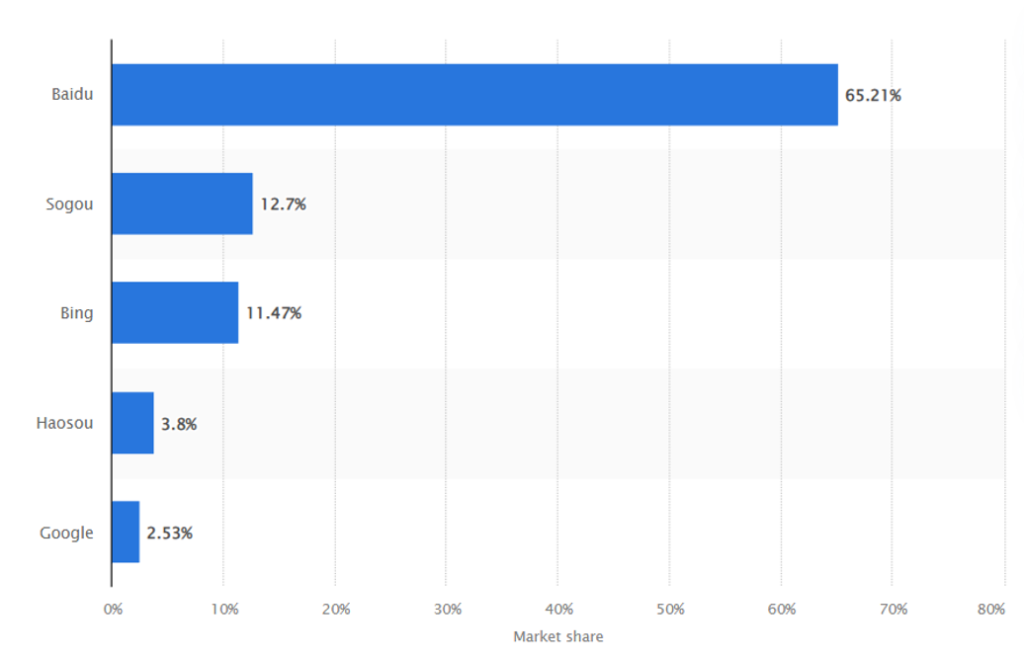
As you can see, Baidu leads the way, and has done for some time. Other emerging search engines such as the Tencent-owned Sogou (which also produces China’s most popular pinyin to Chinese character keyword input method) has always been one to keep an eye on. Bing also continues to operate in China and owns a decent chunk hovering around 10%.
With these numbers in mind however, we’re going to focus on Baidu and how to utilise it and its features in modern day China SEO.
What Does the Baidu SERP Look Like?
Below shows a typical screenshot from the Baidu SERP for the branded term “三星集团” (“Samsung Group):
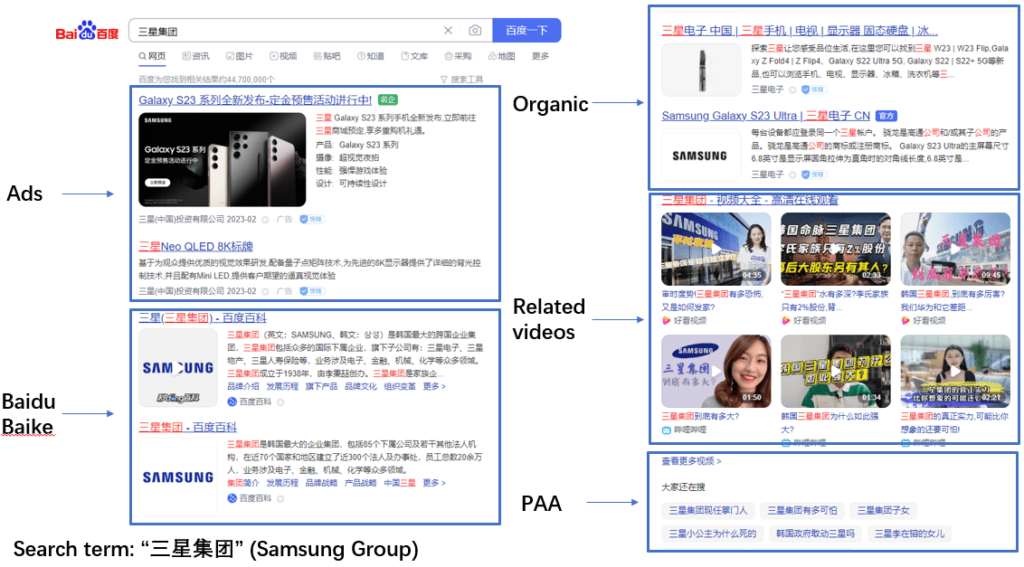
And again a similar screenshot for a non-branded informational query “2023手机推荐” (“phone recommendations 2023”).
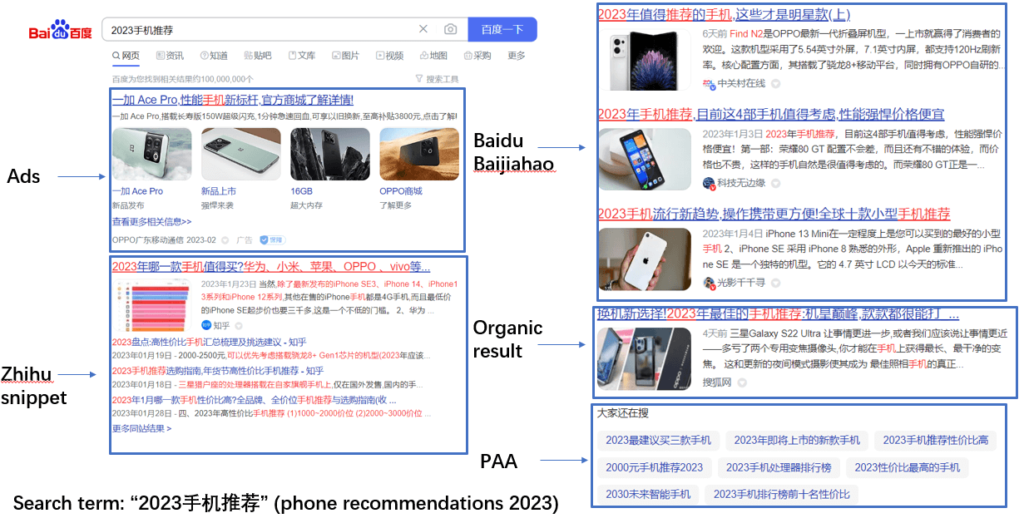
The key takeaways on how Baidu SERPs are made up are:
- Ads take up a large amount of SERP real estate (typically around 30-40% above the fold)
- Baidu’s own products or affiliated products dominate the SERP too: typically you’ll see 2 or 3 results from Baidu Baike, Baidu Zhidao, Baidu Baijiahao and Zhihu among others
- Indeed, Baidu’s own search and web products (of which there are over 60) take up on average 40-60% of results on page one.
- There are usually only 2 to 3 organic results within the top 10 search results, making the competition tough and Baidu likely your biggest competitor in the SERP.
Part 2: Typical China SEO Headaches
This is more from an operational standpoint rather than in regard to technical or on-page SEO differences. Getting the right setup in terms of Baidu accounts, China hosting, CDNs and general web infrastructure forms a lot of the groundwork when it comes to succeeding in SEO for China.
The main takeaway is that your SEO efforts will prosper more if you’re able to achieve some level of in-China hosting as naturally, the Chinese web will favour content using China-approved servers.
Here’s the low-down:
- A lot of Baidu tools, such as Baidu Analytics, Baidu Webmaster Tools and indeed the Baidu SEO help centre are exclusively in Chinese (see my Baidu Analytics guide with translations to help on this front)
- Getting a Baidu account in order to set these tools up without a Chinese phone number and additional Chinese credentials is a pain. Baidu does offer some overseas phone numbers as a route of ascertaining a Baidu account though this does not currently include the UK or EU countries (you can do it from the US and Switzerland however as an example).
- ICP licencing is a legal requirement for any website hosting content within China and follows a convoluted and bureaucratic process in order to get one.
- Being eligible to host content in China and subsequently apply for an ICP licence will require you to have a Chinese business licence which is not applicable for many brands or sites looking to launch in China.
- Even with all this in place, internet blackouts around sensitive political times during the year can take place, and of course the government can choose to censor and block websites as they please.
There Are Some Workarounds
The ICP licencing and in-China hosting will most certainly get you ahead of the pack, though there are plenty of ways in which you ascertain the next best thing if you aren’t in a position to do this.
- Near-China hosting and CDNs will get you a decent degree of site performance and visibility (think South Korea, Taiwan, Hong Kong, Vietnam, Thailand).
- There are plenty of suppliers out there who can help you bridge the gap with a near-China hosting solution that will avert the need for an ICP licence. This will remove a lot of these operational headaches for you. Shout out to Chinafy in particular here.
Part 3: Maximising Baidu SERP Real Estate: Baidu Products
As I mentioned earlier, Baidu itself will likely be your biggest competitor in the SERP owing to the fact that up to 60% of its own products will appear in the top 10 results for many search terms. However, we can use this to our advantage.
Here’s a breakdown of some of the recurring SERP-dominant Baidu web properties that you can get involved in to steer visibility for your brand. All you need is a Baidu account, of course.
Baidu Maps
Local SEO is a big deal for Baidu as it is for Google. Baidu map listings take up a lot of SERP real estate for navigational queries and can be readily claimed, managed and edited providing you have the right credentials. They can also be managed with ease using the Baidu Maps app.
Take a look at this SERP snapshot for the term “Burberry上海” (“Burberry Shanghai):

In this instance, Burberry have got all (if not most) of their Shanghai stores listed on Baidu Maps. Branded navigational queries end up owning a huge chunk of above the fold SERP real estate.
The caveat here from an SEO point of view is that unlike Google Business Profile, brands are unable to link directly back to their websites from Baidu Map listings. However, from a pure branded and visibility perspective, the potential is not to be sniffed at.
Baidu Baike
Baidu Baike is often described as Baidu’s answer to Wikipedia, and offers brands the chance to jump in and create huge amounts of rich content around their brand. Baidu Baike will also typically occupy the top 3 positions on the Baidu SERP for organic results around entities.
Editorial policy is strict of course and again you can’t provide direct links back to your brand site in the form of references, though again the potential for brand awareness is huge.
Take a look at this video I made of Burberry’s Baidu Baike page. There’s vast detail around brand history, key people, product inventories (with images), Burberry’s cultural identity, recent news and more (even company scandals):
When you get to the end of the video, you’ll also see what happens when you click on the article references at the bottom. Baidu will redirect you to a Baike “resources” section showing screenshots from these references, with the example shown in the video being a reference link from the Burberry website.
Within this resources subfolder there is an eventual link to the Burberry website, but guess what? This entire subsection of Baike is blocked by robots.txt and marked up with noindex. Thanks Baidu.
Still, Baidu Baike offers great potential for branding and its prominence in the SERP makes a vital avenue.
Baidu Zhidao
Baidu Zhidao or “Baidu Knows” is a popular Q&A forum and will often pop up for large swathes of informational and long-tail query-led keywords in the Baidu SERP.
As with all these properties, you’ll need a Baidu account to get involved, though Baidu Zhidao offers different levels of verification and opens up the door for users to become micro-influencers within a certain topic. It can be great for getting involved in conversations around your brand to promote awareness.
If you get caught spamming by linking back to your website with your answers expect to be reprimanded, though it’s a great soft power tool with tonnes of content around a host of topics.
Take a look at this screenshot from the Baidu SERP showing a hosting of Baidu Zhidao threads occupying the top spots for the query “Burberry正确发音” (“The correct way to pronounce Burberry”):
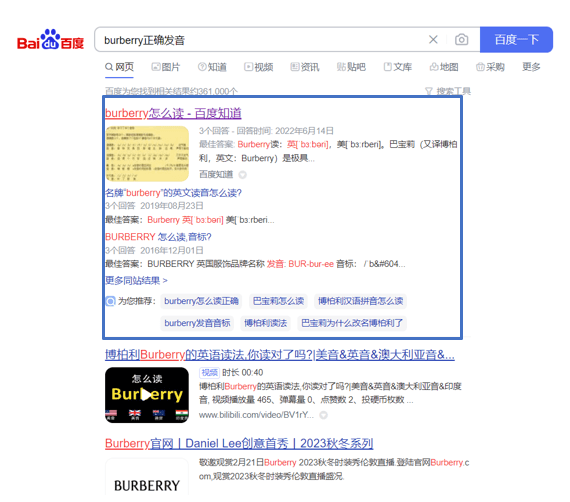
As you can see, there are plenty of rich snippets from Baidu Zhidao featuring threads that touch on a similar search intent. You’ll often see a similar thing in the SERP for long-tail search queries, so get involved in the conversation where you can.
Part 4: Maximising Baidu SERP Real Estate: Multi-Domain Strategy
This section of the talk referenced a recent case study for Baidu SEO where I worked with a client in an industry that is heavily regulated: that being forex trading.
Owing to the potential for unforeseen legislative changes, the project carried with it a degree of risk in terms of rapid rule changing and websites being vulnerable to getting blocked.
Indeed, plenty of industries in China are regulated in terms of web content and can be vulnerable to this risk. Particular industries in this bracket include finance, health, food, environment, entertainment, gaming, and of course anything to do with news, history or politics.
The crux of this multi-domain approach meant spreading risk along various web properties to mitigate this danger.
In this instance, the client in question had a Simplified Chinese version of its main website (on a /cn/ subfolder), a separate “copy” of this site on separate China-centric domains, and smaller lead gen websites that covered search demand for long-form FAQ queries and seasonal offers relevant to the forex industry.
The latter of which were in the form of microsites that we were able to have some fun with in terms of old school churn and burn link building campaigns (not that I’m advocating this in my general SEO work).
These sites were looped together in an overall site ecosystem and were also linked to our social and CRM efforts using the likes of WeChat.
Here’s roughly how it looked:
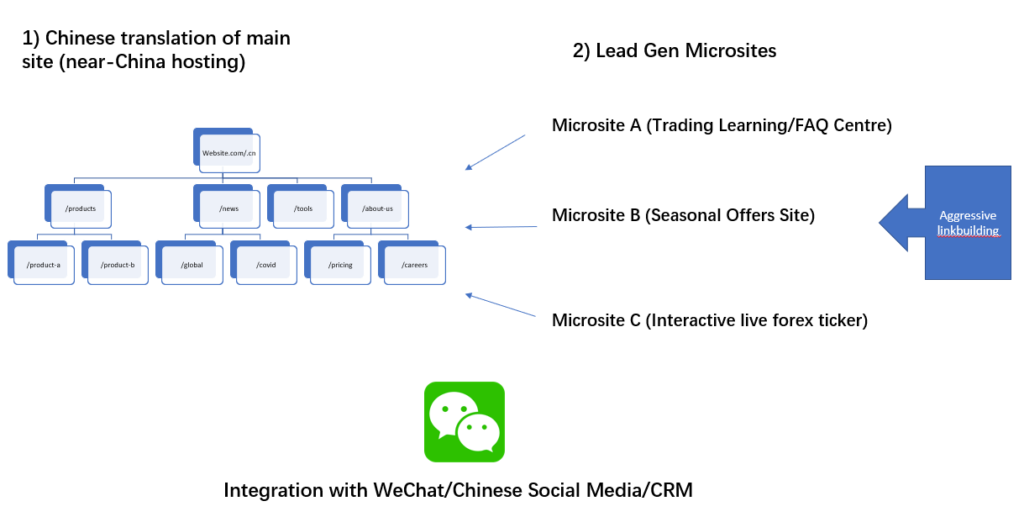
Now I know what you’re thinking. This looks incredibly high-maintenance and stressful, and it was.
You’re also probably wondering why on earth we would consider spreading our assets (in particular the long-form top of funnel content) away from the main domain. It was simply down to the complications with the industry in question and the need to hedge bets, tread carefully but also be smart and dare I say somewhat grey hat when it came to driving leads (again, not endorsing).
Here are some key considerations for this approach:
- While spreading SEO efforts like this across different domains may seem a bit mad, it allows the option to spread risk within regulated industries that could see websites blocked/site outage
- You’re able to experiment and have a bit of fun with sites targeting different unbranded keyword buckets for quick lead gen
- Link building in China is a grey area, though you’ll do well to adhere to similar modern-day quality content marketing practices where possible
- It’s not risk averse and you may need to have a fallback strategy in place with backup domains and automated redirect scripts in case things go awry (I won’t be going into this level of detail on this area here. Get in touch with me if you’d like insights on the failsafe script and protocol we developed for this).
And as with any case study, I’m guessing you’re keen to know the results? Well, harking back to the complications around getting SERP real estate in Baidu that formed the core tenet of the talk, this is what we ended up with:

As you can see, along with some off-page efforts on Baidu products, were able to dominate a good chunk with a combination of our different site assets.
Part 5: China SEO Resources
Aside from what I’ve put out over the years covering the difference between China and Google from a pure SEO standpoint among other things, there are plenty of people doing brilliant stuff on China SEO both in China and elsewhere.
Here’s a link to some useful China SEO resources including key set-up and implementation, tools, guides, and who to follow:
China SEO Tools and Setup
- Get a Baidu account
- ICP Licencing info
- Baidu Webmaster Tools (in Chinese)
- Baidu SEO Help Centre (in Chinese)
- Baidu Analytics (in Chinese)
- 17CE page speed testing tool (in Chinese)
- ChinaZ page speed testing tool (in Chinese)
- Baidu Index content and keyword research tool (in Chinese)
- Dragon Metrics all in one China SEO tool
Useful China SEO Resources
- Ultimate Guide to Baidu SEO in China (Dragon Metrics)
- SEO for China: Chinese Search Engine Optimization (book by Kun Tang and Marcus Pentzek)
- Tianxianmao SEO forum (in Chinese)
- Heimaoxuexi SEO forum (in Chinese, meaning “Black Hat World”, so have fun)
Who to Follow for More China SEO Tips
- Kun Tang
- Marcus Pentzek
- Adam Di Frisco
- Du Ye (you will need a Weibo account)
- Karl Gao (you will need a WeChat account; WeChat ID is karl_gao)
- Bai Yang SEO Official WeChat Page (you will need a WeChat account)
And, as promised, here are my slides from the talk embedded below:
A big thank you to Search London for continuing to organise such a lovely event, and a huge thank you in particular to Jo Turnbull and Tim Sheed for inviting me back to talk.